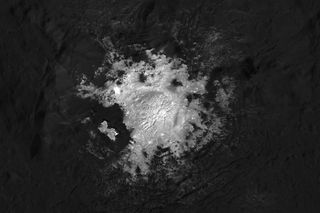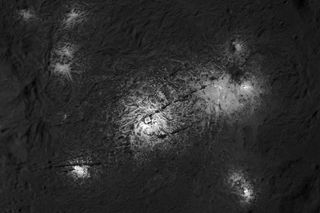
Some parts of the dwarf planet Ceres harbored pockets of near-surface water for millions of years in the recent past, a new study suggests.
Researchers analyzed observations of Ceres' Occator Crater made by NASA's Dawn spacecraft, which studied the dwarf planet from orbit from March 2015 to October 2018, when the probe ran out of fuel.
The 57-mile-wide (92 kilometers) Occator sports dramatic bright spots, which Dawn team members determined are salts left behind when briny water boiled away into space. This water likely began as subsurface ice, which was melted by the intense heat of the impact that created Occator about 20 million years ago. Once liquefied, some of it bubbled up to the surface via fissures and was lost. [In Pictures: The Changing Bright Spots of Dwarf Planet Ceres]
Such sublimation occurred as recently as 4 million years ago; that's the apparent age of the youngest deposits on Occator's floor. And that 16-million-year gap is puzzling, researchers said.
"It’s difficult to maintain liquid so close to the surface," study co-author Julie Castillo-Rogez, a planetary scientist at NASA’s Jet Propulsion Laboratory (JPL) in Pasadena, California, said in a statement. Indeed, previous research has estimated that "cryomagma" could stay liquid in Occator's near subsurface for just 400,000 years or so.
But the new study provides at least a partial answer. Modeling work by Castillo-Rogez and study lead author Marc Hesse, an associate professor at the University of Texas' Jackson School of Geosciences, suggest that Occator's near subsurface contains insulating materials, which could have kept the "cryomagma" liquid for about 10 million years.

"Now that we're accounting for all these negative feedbacks on cooling — the fact that you release latent heat, the fact that as you warm up the crust it becomes less conductive — you can begin to argue that if the ages are just off by a few million years, you might get it," Hesse said in the same statement.
Get the Space.com Newsletter
Breaking space news, the latest updates on rocket launches, skywatching events and more!
"They used more up-to-date data to create their model,” said JPL planetary geologist Jennifer Scully, who was not involved in the new research. "This will help in the future to see if all of the material involved in the observed deposits can be explained by the impact, or does this require a connection to a deeper source of material. It’s a great step in the right direction of answering that question."
The new study was published in December in the journal Geophysical Research Letters.
The Dawn spacecraft enjoyed a long and very productive life. Before its work at the 590-mile-wide (950 km) Ceres, Dawn orbited the protoplanet Vesta, which is about 330 miles (530 km) wide. Vesta and Ceres — the two largest objects in the asteroid belt between Mars and Jupiter — are considered leftovers from the solar system's planet-formation days, and Dawn's mission was designed to help shed light on this mysterious, long-ago epoch (hence the name, which is not an acronym).
Dawn was the first probe ever to orbit a dwarf planet, and the first to circle two celestial bodies beyond the Earth-moon system.
Mike Wall's book about the search for alien life, "Out There" (Grand Central Publishing, 2018; illustrated by Karl Tate) is out now. Follow him on Twitter @michaeldwall. Follow us on Twitter @Spacedotcom or on Facebook.
Join our Space Forums to keep talking space on the latest missions, night sky and more! And if you have a news tip, correction or comment, let us know at: community@space.com.

Michael Wall is a Senior Space Writer with Space.com and joined the team in 2010. He primarily covers exoplanets, spaceflight and military space, but has been known to dabble in the space art beat. His book about the search for alien life, "Out There," was published on Nov. 13, 2018. Before becoming a science writer, Michael worked as a herpetologist and wildlife biologist. He has a Ph.D. in evolutionary biology from the University of Sydney, Australia, a bachelor's degree from the University of Arizona, and a graduate certificate in science writing from the University of California, Santa Cruz. To find out what his latest project is, you can follow Michael on Twitter.
